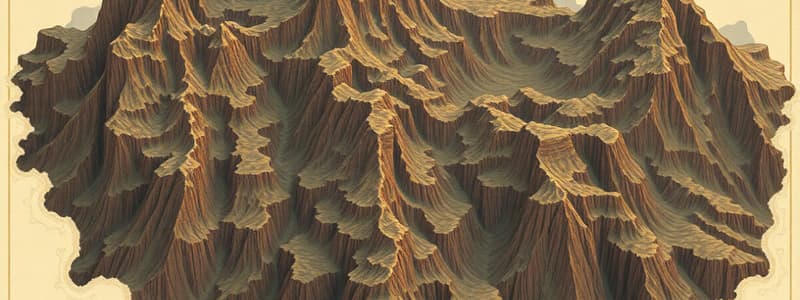Podcast
Questions and Answers
What is the primary driver of erosion that moves soil and rock?
What is the primary driver of erosion that moves soil and rock?
- Solar energy
- Human infrastructure
- Rivers, ice, wind, and gravity (correct)
- Population growth
Which of the following best describes the hydrologic cycle?
Which of the following best describes the hydrologic cycle?
- The containment of water in glaciers
- Movement of water driven by solar energy, winds, and gravity (correct)
- The resulting collection of rainfall into lakes
- The process of humans creating water reservoirs
What proportion of Earth's freshwater is available for human use?
What proportion of Earth's freshwater is available for human use?
- Approximately 50%
- Nearly 75%
- About 25%
- Less than 1% (correct)
Which type of natural resource is classified as non-renewable?
Which type of natural resource is classified as non-renewable?
Why is understanding the importance of natural resources crucial in developing countries?
Why is understanding the importance of natural resources crucial in developing countries?
What is the main purpose of plate tectonics in geology?
What is the main purpose of plate tectonics in geology?
Which type of plate movement is responsible for creating the Himalayan mountains?
Which type of plate movement is responsible for creating the Himalayan mountains?
What percentage of the Earth's surface is covered by oceans?
What percentage of the Earth's surface is covered by oceans?
What type of landform is formed when land is surrounded by water on three sides?
What type of landform is formed when land is surrounded by water on three sides?
Which feature is created by divergent plate movement?
Which feature is created by divergent plate movement?
What characterizes wetlands in terms of their water coverage?
What characterizes wetlands in terms of their water coverage?
What defines a desert in terms of precipitation?
What defines a desert in terms of precipitation?
Which of the following bodies of water is characterized as natural streams flowing into another body of water?
Which of the following bodies of water is characterized as natural streams flowing into another body of water?
Flashcards are hidden until you start studying
Study Notes
Understanding Landforms
- Landforms are natural features on Earth's surface, encompassing both land and water elements.
- There are numerous landforms, differentiated by subtle physical characteristics.
Geology and Plate Tectonics
- Geology focuses on Earth's solid materials, including rocks and changes due to natural forces.
- Plate tectonics explains Earth's crust structure through interactions of rigid lithospheric plates.
- Major lithospheric plates include African, North American, and Pacific; minor ones include Arabian and Nazca.
- Types of plate movements:
- Divergent (plates moving apart),
- Convergent (plates moving towards each other),
- Transform (plates sliding horizontally past one another).
Plate Movements and Landform Examples
- Divergent movement results in features like the Great Rift Valley, often formed in ocean floors.
- Convergent movement leads to subduction zones, creating mountain ranges such as the Himalayas.
- Transform movement causes lateral sliding, resulting in seismic activity like the San Andreas fault.
Oceans and Coastal Features
- Oceans cover 71% of Earth's surface, including Arctic, Atlantic, Indian, Pacific, and Southern oceans.
- Coastal areas are dynamic, shaped by waves and tides impacting the land.
- Coral reefs, e.g., Great Barrier Reef, are formed by skeletal remains of small marine organisms.
Bodies of Water and Waterways
- Rivers are crucial water sources, flowing into larger bodies and supporting human civilizations.
- Lakes can be freshwater or saltwater, with significant examples like the Great Lakes in North America.
- Wetlands are shallow water areas benefitting wildlife and acting as natural water filters.
Unique Landforms and Features
- Islands are land surrounded by water, contributing to biodiversity through unique species.
- Peninsulas, like Panama, are landforms bordered by water on three sides.
- Deserts are arid regions receiving less than 10 inches of rainfall annually.
Erosion and Changing Landforms
- Erosion occurs through the movement of rock and soil, driven by natural forces (water, wind, ice, gravity).
- Human activities (e.g., building infrastructure) alter landforms and can affect local ecosystems.
- Landform changes influence human settlement, often favoring agricultural viability.
Water on Earth and the Hydrologic Cycle
- Freshwater availability on Earth is limited; a significant portion is trapped in glaciers, with only 1% accessible for consumption.
- The hydrologic cycle illustrates water movement driven by solar energy, gravity, and wind, affecting climate and ecosystems.
- Surface water bodies, including rivers, lakes, and estuaries, are vital to ecological diversity and climate regulation.
Natural Resources and Sustainability
- Natural resources are categorized as renewable (air, water) and non-renewable (minerals, fossil fuels).
- These resources are essential for human survival and energy but face risks of depletion, particularly in developing areas.
- Recognizing the significance of natural resources is key for promoting sustainable practices and environmental stewardship.
Studying That Suits You
Use AI to generate personalized quizzes and flashcards to suit your learning preferences.




